

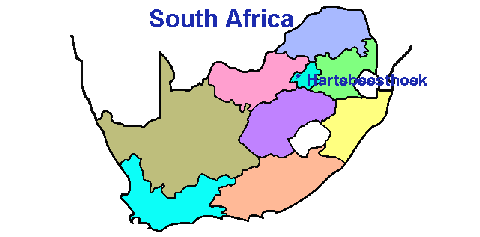
|
|---|
The Observatory began as Deep Space Station 51, built in 1961 by the National Aeronautics and Space Administration (NASA) of the United States of America. An 85 foot = 26 metre diameter antenna was used to get data from, and send commands to, many unmanned US space probes going beyond Earth orbit. These included the Ranger, Surveyor and Lunar Orbiter spacecraft which landed on the Moon or mapped it from orbit, the Mariner missions which explored the planets Venus and Mars and the Pioneers which measured the Sun's winds.
The station was handed over to the South African Council for Scientific and Industrial Research (CSIR) in 1975 and was converted to a radio astronomy observatory. In 1988 the observatory became a National Facility operated by the Foundation for Research Development (FRD). In 1999 the FRD was restructured as the National Research Foundation (NRF).
The original function of the observatory post-NASA was purely research in radio
astronomy, but a new science developed at HartRAO from the 1980's,
namely Space Geodesy, i.e. geodesy using space
techniques. The radio telescopes are used for both astronomy and space
geodesy, and we have other dedicated space geodesy instrumentation.
Research Instrumentation at HartRAO
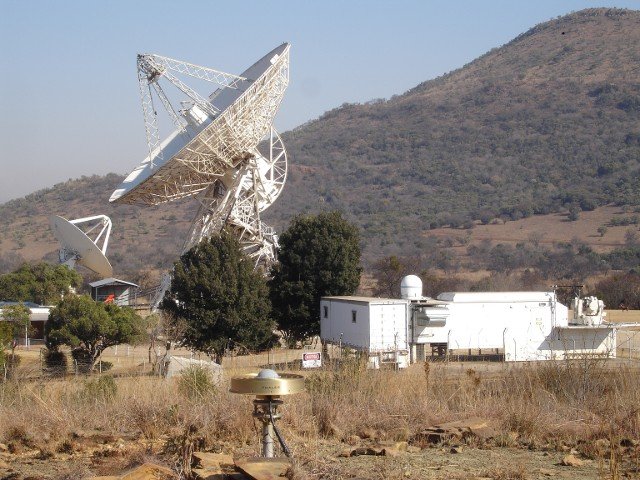
The 26m Radio Telescope

|
|---|
To study the hot gas in our galaxy, the Milky Way, the radio emission from the whole southern sky was mapped with this telescope by a team from Rhodes University. Part of the map is shown above.
Jets of hot gas shooting out of distant galaxies produce what are called radio galaxies, blazars and quasars. The jets come from very massive collapsed objects, which are likely to be black holes. The jets aimed towards us may seem to move faster than light and can appear brighter than a billion suns. The nearest radio galaxy to our Milky Way is known as Centaurus A or NGC5128, and it is seen as the diagonal red streak in the upper centre of the image above. These jets cover nearly 10 degrees on the sky and each jet is about 1 million light years in length.
Atoms and molecules in space can produce radio emission at characteristic frequencies. This emission is studied using a spectrometer.
For example, newly formed massive stars excite intense beams of radio waves, called masers, from molecules such as water (H2O), hydroxyl (OH) and methanol (CH3OH) in the clouds of gas surrounding the new stars. Many methanol masers in the southern Milky Way were discovered using the 26m telescope.
Stars near the end of their lives can also produce masers. These stars swell enormously, becoming red giant stars. Their outer layers are thrown off in violent pulsations, and form dense clouds of gas and dust that blow away from the star. Hydroxyl masers can occur within these clouds. They vary in step with the star's pulsations. The hydroxyl radio emission from these stars has a characteristic double-peaked profile, shown below. As the star pulsates the maser strength increases and decreases, as seen in the three spectra coloured green, yellow and red. From repeated observations of the masers the size of the masing cloud and the distance to the star can be found.
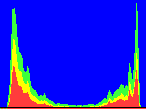
|
|---|
Dying stars more massive than the Sun produce a quite different type of radio emission. After a supernova explosion, stars of sufficient mass collapse under their own gravity to form a ball of neutrons about 20km in diameter. These neutron stars spin rapidly and have strong magnetic fields. These fields are so strong that they can produce beams of radio emission from above their magnetic poles. A telescope pointing towards the star then sees a pulse of radiation each time the spinning beam flashes through the direction towards the telescope. The effect is the same as the flashes we see from the rotating red light on top of a fire engine. The spin rate of some young pulsars can jump suddenly and spin rates can also show slow wandering. We can test mathematical models of the interiors of these exotic objects by predicting their behaviour and comparing this to what we observe from the actual pulsars.

|
|---|
HartRAO co-operates with radio telescopes on other continents to form a virtual telescope nearly the size of the Earth. This technique is called Very Long Baseline Interferometry (VLBI). Radio telescopes have also been put into space and a virtual telescope even larger than the size of the Earth can be created by using orbiting radio telescopes. The radio telescopes at HartRAO are currently the only ones in Africa capable of VLBI, but this is changing with the development of the Karoo Array Telescope and the Square Kilometre Array.
VLBI lets us see very fine details in radio sources. If two radio transmitters were placed two meters apart on the Moon, a VLBI network would be able to "see" them as being seprate objects. This method is used, for example, to map detailed maps of masers around stars in the Milky Way and the jets in quasars.
HartRAO is a member of the European VLBI Network (EVN) and also operates with the Australia Telescope Long Baseline Array (AT-LBA).
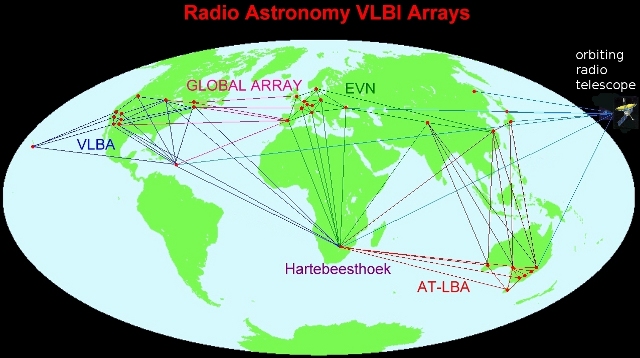
|
|---|
Quasars are so distant from the Earth that they appear fixed in space. By observing them with a VLBI network, we can measure the distances between the radio telescopes in the network to an accuracy of one centimetre. This lets us measure, for instance, the slow drift of the continents over the surface of the Earth and the continuously changing tilt and rate of rotation of the Earth. The 26m telescope was used to establish the absolute reference point for the country's National Survey system. This is known as the Hartebeesthoek94 Datum. The 26m and 15m radio telescopes at HartRAO participate in geodetic VLBI experiments as part of the International VLBI Service for Geodesy and Astrometry (IVS). Progress with geodetic VLBI observations can be watched at IVS Live. The results from these experiments can be found at the IVS Analysis Coordinator.
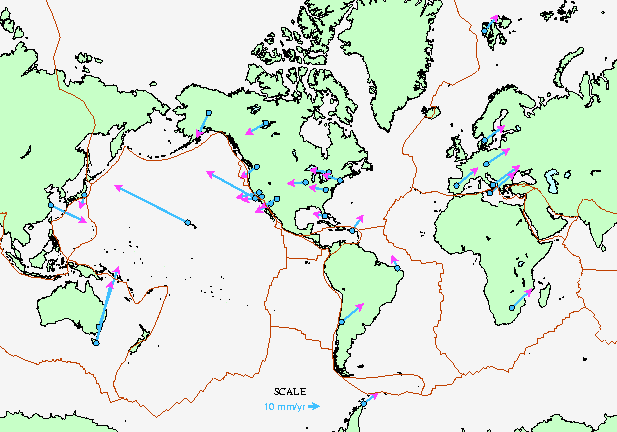
|
|---|
The laser ranger fires very short, intense laser pulses at the satellites. The satellites are equipped with corner-cube reflectors which reflect the light back in the direction from which it came. An optical telescope and detector then picks up the (very weak) return flash. The difference in time between transmitting the pulse and receiving the return flash then gives the distance to the satellite, as the speed at which light travels is accurately known.

|
|---|
HartRAO is developing another laser ranging system based on a donated French laser ranger that utilises a 1m optical telescope. This system will be equipped with a powerful laser and the intention is that it should be able to range to the corner-cube reflector arrays left on the Moon by Apollo astronauts and unmanned Soviet Lunokhod missions, as well as to satellites in Earth orbit.
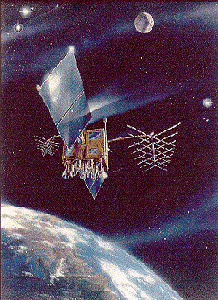
|
|---|
Data from all three techniques are used by the International Earth Rotation Service (IERS) to measure the Earth's rotation rate and orientation in space. These measurements and the corrections from them are needed for GNSS receivers such as GPS to give accurate positions to the many users of these systems.
Outputs from some of HartRAO's geodesy instrumentation can be seen at the HartRAO geophysical data pages.
School, public and group visits to the observatory are used to raise the awareness and understanding of astronomy, science and technology.
Teacher workshops are run in all the northern provinces of the country. These are designed to assist teachers in understanding and presenting astronomy-related topics in the current school curriculum.

|
|---|
Enquiries:
e-mail:
info@hartrao.ac.za
phone: +27 12 301-3100 fax: +27 12 301-3300
post: HartRAO, PO Box 443, Krugersdorp 1740, South Africa.
World Wide Web:
http://www.hartrao.ac.za
